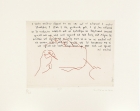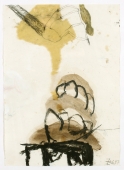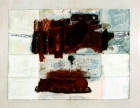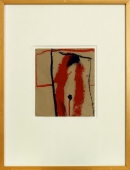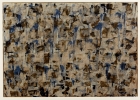
Artist | Anke Doberauer (*1962)
https://www.artist-info.com/artist/Anke-Doberauer
Biography
Biography
born in 1962
About the work (english / deutsch)
About the work (english / deutsch)
In General
Why is not the male gender as good as absent among paintings of nudes? There are numerous possible explanations: The absence may stem from the feeling of shame predominating the nude male, from the wish to preserve his mystery, to protect his potential for conquest. It may, again, come from the quasi-impossibility of depicting the erect male sex, whereas the female body can fully express lust. Admittedly, Picasso dared do it, although only in works in which the figure was not construed realistically, but where instead the man becomes a satyr. It is a simple fact that the nude male body leads only a marginal existence in painting - with the exception of famous, bellicose, and triumphant figures.
Portraits
This is why Anke Doberauer's portraits stand out quite sharply from the way in which painting customarily presents the body, especially the male body. For she only paints male portraits, with their sex visible, openly erotic, presented merely as subjects exposed to the gaze of the painter. In other words, this oeuvre is uniqe in that the male body is not brutalized, but, permeated by painting, becomes a sensual, troubling, provocative body characteristics generally to be found in depictions of the female body. This display is enhanced by the choice of strong, aggressive, indeed vulgar colors, which underscore the deliberate exhibition of the body. These paintings are rendered even more troubling by the reliance on a most severe realism, used to better express the fact that they favor the ambivalent und ambiguity, und are at any rate distinctfrom the real. In Anke Doberauer's pictures the body displayed stands precisely for what it is, namely the painter's subject matter. Her painting thus avoids the compulsions associated with a factual portrayal and the laws for transposing the real into the realm of metaphor. She also sidesteps the clumsiness of paintings of historical subjects - and we all know how many a contemporary famous German painter basks in this genre. Doberauer's paintings, by contrast, have an ambiguous status: the coordinates lie between an ironic display of the classic figure - and here we could mention some of the old French and Spanish masters - and the glitter of ad images, where the sterile body exposes nothing which could make it shudder, but merely present a fleshless, empty, reified model. The male body thus laid bare, in an artificial atmosphere and in a banal and at the same time a slightly absurd stance, also says nothing about the painted flesh, even if the presence of the body attests to a certain truthfulness in the gesture. But the truth of the picture is not to be found on its surface: It is both this side of the painted skin und over and above it.
Anke Doberauer's paintings, which clearly present their inherent paradoxes, are risqué. Strangely contemporary, they are the site of ambiguity. One could consider them a nostalgic, historical rekindling of the achievements of the modernity, or a perversion of the same. That would be to categorize them. However, they are based precisely in the impossibility of identifying them with labels. The picture does not say the truth, but only a part of the truth of painting: It is an experience of boundaries. This painting strips even illusion bear through a representation that verges on being unseemly, through a "surfeit of representation", through the application of illusionist pictorial means. How should we therefore grasp the mystery of the image, the strangeness of its presence? By means of the overt lure of the images, and positioned somewhere between cliché and art history, these paintings stem from a dedication to the boundaries of painting. This could be their exclusive reality.
German text by Paul Hervé Parsy (Translated from the French by Joachim Lennert) / Translation by Jeremy Gaines
(Extract - Full printed version available in the Museum)
MMK - Museum für Moderne Kunst, Frankfurt am Main
Allgemeines
Warum ist das männliche Geschlecht in der Aktmalerei so gut wie nicht präsent? Die möglichen Erklärungen sind zahlreich: Sie können auf das den nackten Manne beherrschende Schamgefühl zurückzuführen sein, auf den Willen, sein Geheimnis, sein Eroberungspotential zu bewahren. Es kann sich um die Quasi-Unmöglichkeit handeln, das erigierte männliche Geschlecht darzustellen, während der weibliche Körper uneingeschränkt Wollust zum Ausdruck bringen kann. Gewiß, Picasso hat es gewagt, jedoch in Werken, bei denen die Gestalt nicht realistisch gedacht ist, sondern wo der Mann zum Satyr wird. Es ist eine Tatsache, daß der nackte männliche Körper - abgesehen von Gestalten des Ruhmes, des Krieges, des Triumphes - in der Malerei nur ein Dasein am Rande führt.
Porträts
Die Porträts von Anke Doberauer heben sich deshalb abrupt von dem ab, was die Malerei üblicherweise vom Körper darzustellen vorgibt, insbesondere vom männlichen Körper. Denn sie malt nur Männerporträts, mit sichtbarem Geschlecht, offen erotisch, als bloße Sujets, die sich dem Blick des Malers darbieten. Die Singularität dieser Arbeit liegt also darin, daß der Körper des Mannes keineswegs verroht wird, sondern, von der Malerei durchdrungen, ein sensueller, sinnverwirrender, provokatorischer Körper ist - Eigenschaften, die man im allgemeinen in der Darstellung des weiblichen Körpers findet. Zu dieser Zurschaustellung kommt noch die Wahl kräftiger, aggressiver, ja vulgärer Farben, die diese Exhibition verstärken. Was diese Arbeit noch verwirrender macht, ist, daß die Malerei einen strengsten Realismus zur Schau stellt, um gerade damit besser auszudrücken, daß sie eher auf der Seite des Doppelsinnigen, der Mehrdeutigkeit steht, jedenfalls daß sie vom Reellen getrennt ist. In den Bildern von Anke Doberauer steht der ausgestellte Körper für das, was er ist: ein Sujet des Malers. Ihre Malerei entzieht sich also den Zwängen der Tatsachendarstellung und den Gesetzen der Übertragung ins Metaphorische. Sie entzieht sich auch den Schwerfälligkeiten der Historienmalerei - und man weiß, wie sehr sich manch berühmte zeitgenössische Persönlichkeit der deutschen Malerei in diesem Genre gefällt. Die Malerei bekommt hier einen mehrdeutigen Status, dessen Orientierungspunkte zwischen einer ironischen Darstellung der klassischen Gestalt - und man könnte einige alte französische und spanische Meister anfuhren - und dem Tand der Werbebilder schwanken könnten, wo der sterile Körper nichts von dem enthüllt, was ihn erbeben läßt, sondern vielmehr ein fleischloses, leeres, verdinglichtes Modell wiedergibt. Der so entblößte männliche Körper, in einer künstlichen Atmosphäre und in einer banalen und zugleich leicht lächerlichen Haltung, sagt auch nichts über das gemalte Fleisch aus, selbst wenn die Präsenz des Körpers von einer gewissen Wahrheit der Geste zeugt. Aber die Wahrheit des Bildes befindet sich nicht auf seiner Oberfläche: Sie ist zugleich diesseits und jenseits der gemalten Haut.
Die Malerei von Anke Doberauer, die klar ihre Paradoxa darstellt, ist gewagt. Seltsam zeitgenössisch, ist sie der Raum der Ambiguität. Man könnte sie als ein nostalgisches, historisches Wiederaufflammen oder als eine Perversion der Errungenschaften der Modernität ansehen. Das würde, sie kategorisieren. Doch gerade in der Unmöglichkeit der Zuordnung begründet sie ihre Präsenz. Das Bild sagt nicht die Wahrheit, sondern nur einen Teil der Wahrheit der Malerei: eine Erfahrung der Grenzen. Durch eine Darstellung am Rand der Unschicklichkeit, durch ein "Zuviel an Darstellung", durch die Verwendung illusionistischer Bildmittel legt diese Malerei selbst die Illusion bloß. Wie soll man also das Geheimnis des Bildes, die Fremdartigkeit seiner Präsenz erfassen? Durch die offene Illusion der Darstellung entspringen diese Bilder zwischen Klischee und Geschichte der Malerei einem Impuls durch die Malerei. Dies könnte ihre alleinige Realität sein.
Text von Paul Hervé Parsy (aus dem Französischen übersetzt von Joachim Lennert)
(Auszug - Der vollständige Text ist als Informationsblatt beim Museum erhältlich)
MMK - Museum für Moderne Kunst, Frankfurt am Main
 offers / Requests offers / Requests  |
About this service |
|---|
 Exhibition Announcements Exhibition Announcements  |
About this service |
|---|
 Visualization |
Learn more about this service | ||
|---|---|---|---|

Interested in discovering more of this artist's networks?
3 easy steps: Register, buy a package for a visualization, select the artist.
See examples how visualization looks like for an artist, a curator, or an exhibition place: Gallery, museum, non-profit place, or collector.

Exhibition History

|
SUMMARY based on artist-info records. More details and Visualizing Art Networks on demand. Venue types: Gallery / Museum / Non-Profit / Collector |
||||||||||||
| Exhibitions in artist-info | 10 (S 4/ G 6) |
Did show together with - Top 5 of 99 artists (no. of shows) - all shows - Top 100
|
||||||||||
| Exhibitions by type | 10: 6 / 1 / 3 / 0 | |||||||||||
| Venues by type | 8: 4 / 1 / 3 / 0 | |||||||||||
| Curators | 2 | |||||||||||
| artist-info records | Aug 1991 - Jan 2010 | |||||||||||
|
Countries - Top 4 of 4 Germany (5) Switzerland (3) Netherlands (1) France (1) |
Cities - Top 5 of 7 Zürich (3) Frankfurt am Main (2) Recklinghausen (1) Giessen (1) Bremen (1) |
Venues (no. of shows )
Top 5 of 8
|
||||||||||
Curators (no. of shows)
Top 2 of 2
|
| Kunsthalle Giessen | S | Oct 2009 - Jan 2010 | Giessen | (27) | +0 | |
| Mai 36 Galerie | S | Oct 2001 - Nov 2001 | Zürich | (118) | +0 | |
| Mai 36 Galerie | S | Mar 2000 - May 2000 | Zürich | (118) | +0 | |
| Galerie Brigitte Trotha | S | Oct 1999 - Nov 1999 | Frankfurt am Main | (19) | +0 | |
| Kunstpreis junger Westen - Kunsthalle Recklinghausen | G | Nov 1997 - Jan 1998 | Recklinghausen | (68) | +0 | |
| Mai 36 Galerie | G | Jun 1997 - Jun 1997 | Zürich | (118) | +0 | |
| Keep reading |














